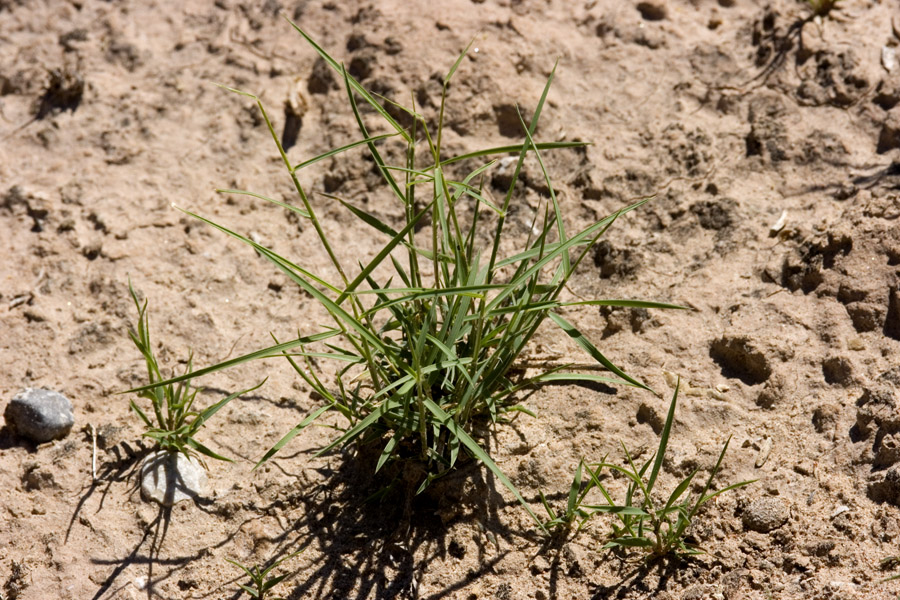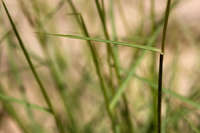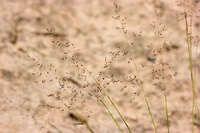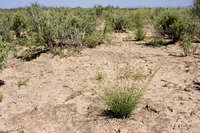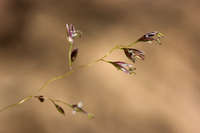|
|
|
|
Family: Poaceae
gyp dropseed
|
Plants perennial; cespitose, bases hard and knotty, not rhizomatous. Culms10-50(60) cm tall, 0.7-1.2 mm thick. Sheaths rounded below, occasionally glabrous, usually villous to tomentose along the margins and back, with soft, kinky hairs to 4 mm; ligules 0.2-0.4 mm; blades (0.6)1.5-6(7) cm long, 1-1.5 mm wide, involute, stiff, spreading at right angles to the culm, glabrous abaxially, scabridulous adaxially, margins smooth. Panicles 3-10 cm long, (0.3)1-5(6) cm wide, longer than wide, ultimately open, subovate, lower portion often included in the uppermost sheath; lower nodes with 1-2 branches; primary branches 0.5-5 cm, appressed or spreading to 90° from the rachis; secondary branches appressed or spreading, without spikelets on the lower 1/8-1/4; pedicels 0.2-2 mm, appressed or spreading. Spikelets 1.4-2.1 mm, purplish. Glumes unequal, linear-lanceolate to ovate, membranous; lower glumes 0.5-1.1 mm; upper glumes 1.3-2 mm, from slightly shorter than to subequal to the florets; lemmas 1.4-2.1 mm, ovate, membranous, glabrous, acute; paleas 1.4-2.1 mm, ovate, membranous; anthers 0.7-1 mm, purplish. Fruits 0.7-1 mm, orangish to whitish. 2n = 40. Sporobolus nealleyi grows in sandy and gravelly soils, usually in those derived from gypsum, or near alkaline habitats associated with desert grasslands. It is known only from the southwestern United States, where it grows at 700-3000 m. FNA 2003 Common Name: gyp dropseed Duration: Perennial Nativity: Native Lifeform: Graminoid General: Tufted perennial grass from a hard and knotty, non-rhizomatous base; stems 10-60 cm tall, 1 mm thick. Vegetative: Sheaths conspicuously ciliate at the apex; ligules 0.2-0.4 mm; blades 1-7 cm long, 1 mm wide, involute, stiff, spreading at right angles to the culm, scabridulous on the upper surface and glabrous on the lower surface. Inflorescence: Panicles 3-10 cm long, to 6 cm wide, longer than wide, ultimately open, subovate in outline, the lower portion often included in the uppermost sheath; lower nodes with 1-2 branches; primary branches 0.5-5 cm, appressed or spreading to 90- from the rachis; secondary branches and pedicels short, appressed to spreading; spikelets 2 mm, single-flowered, purplish; glumes unequal, linear-lanceolate to ovate, membranous; lemmas 2 mm, ovate, membranous, glabrous, acute; caryopsis 1 mm, orangish to whitish. Ecology: Found in sandy and gravelly soils, usually in those derived from gypsum, or near alkaline habitats associated with desert grasslands, from 2,000- 10,000 ft (610-3048 m); flowers August-October. Distribution: sw US in CA, AZ, CO, NM and TX. Notes: Sporobolus species have single-seeded spikelets with unequal glumes, no awns, and most often small seeds which readily fall after maturing, hence the common name "dropseed." S. nealleyi is a low, fairy ring-forming perennial Sporobolus with wiry stems; narrow, short blades; and small, usually open inflorescences. Look also for the short tuft of basal blades and the cauline blades forming right angles to the stems. It is an uncommon species, found on gypsiferous or alkaline soils. Ethnobotany: unknown Editor: AHazelton 2015 Etymology: Sporobolus is Greek for "seed-caster;" nealleyi honors Texan botanist Greenleaf Cilley Nealley (1846-1896). |


